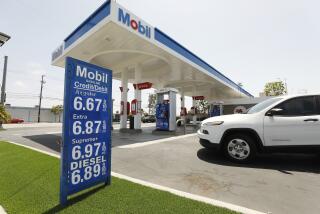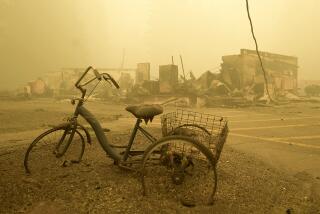Can Reserve Be Used to Replace Faulty Furnaces?
- Share via
Question: I live in a condominium association with less than 20 units. The furnace in each of the units is in the attic. The Consumer Product Safety Commission has identified potentially hazardous defects in the furnaces.
Our association’s declaration of covenants, conditions and restrictions (CC&R;) specifies that maintenance and replacement of the furnace is the responsibility of the owner; however, the owners would like to use reserve funds to replace the furnaces and pay back the reserve money through a special assessment.
The board of directors is concerned about using reserve funds for this purpose. Can you provide any insight? Can you refer us to any sources of information that might assist us?
Answer: Because the owners are responsible for their own furnaces, it is beyond the scope of the association to handle this matter. As a precaution, the association board should communicate with all of the owners in writing to ensure that everyone knows about the problem. If your condominium units are attached, your safety could depend upon the actions of your neighbors. Therein lies the dilemma for the association.
I referred your problem to Jon Epsten, an attorney with the law firm of Epsten, Grinnell & Howell in San Diego. The firm’s Web site, https://www.epsten.com, provides information about the CPSC warning.
Epsten advises: “The issue of addressing defective attic furnaces by a homeowners association where the furnaces are the individual owners’ responsibility is problematic. The board of directors’ obligation is to its association members as a whole. Since they are aware of the problem, I would suggest that the board immediately notify the owners of the defective units to stop using them. The utility company or a licensed mechanical engineer should inspect the units.
“If the board decides that it is in the best interests of the owners to make the association responsible for the furnace replacements, I would suggest the following:
“1) Send a letter to all of the owners explaining the problem and highlighting the safety issues.
“2) Propose an amendment to the CC&R; that would change the responsibility to the association on a one-time basis only. The amendment should exclude any further involvement by the association including repairs, maintenance and warranty claims.
“3) Concurrent with the amendment vote, the members should be presented with a vote on the special assessment for the replacement of the furnaces. If not all furnaces are affected, the amendment should be drafted to only apply to the affected owners.
“4) The owners and the association should register with the class-action lawsuit, which is being handled by Rob D. MacDonald, attorney with the law firm of Richard G. White, 333 W. Santa Clara St., No. 910, San Jose, CA 95113, phone (408) 345-4000.
“The board must not undertake the replacement unless they have the responsibility via the amendment. The responsibility is derived from the governing documents. Absent that express authority, the board is stuck with encouraging owners to replace the units, as necessary, on their own accord, but demand that they stop using them in the interim,” said Epsten.
MacDonald concurs with Epsten’s advice and offers the following information: “Approximately 149,000 of these furnaces were installed. The fire danger from the defective furnaces can be reduced, but the original installation will eventually cause overheating of the wood underlayment, resulting in a fire. Prior to replacing the defective furnaces, owners should document to the fullest extent any and all information about the furnace, including the manufacturer, trade name, model and serial numbers. By registering with the class action, individual owners will be kept informed of the status of the suit as well as other information that might be helpful to them in the future.”
The Times has previously published a list of the manufacturer names, trade names and models that have been identified as having possible defects. This information is also available at the Orange County Fire Authority Web site at https://www.ocfa.org.
Lack of Storage Poses a Dilemma
Q: Our association has open carports that are assigned and deeded to the owners of the units. The units have balconies. The carports and balconies are “exclusive-use common areas” and the association does not allow items to be stored in or on these exclusive use common areas.
The complex is in a beach resort area, across the street from a well-used bike path. Many residents use bicycles to commute. The only bike storage area provided by the association is a bike rack that is in plain view of passersby. Owners have been fined for storing their bikes and other items in the carports or on their balconies. When the bikes have been moved to the bike racks, they have been stolen.
The units are less than 1,000 square feet, so there is limited storage within the units and no storage space on the exterior. Residents do not have any safe place to store baby strollers, surfboards, bikes and other bulky items.
Is the association liable for the stolen items since the association has not provided a safe storage place? What methods have other associations used to handle storage?
A: I am not an attorney or an insurance expert so I won’t guess about liability, but I can offer suggestions for dealing with the lack of storage. The board of directors should study the alternatives and consult an attorney before taking any action.
Some associations allow owners to build locked storage closets in their garage spaces. The carports are exclusive-use common areas and visible, so the association probably has the right to determine the type of construction for the safety and appearance of the storage closets. Many associations allow a wall- or ceiling-mounted storage closet that projects into the space above the car’s hood. Since you have open carports instead of garages, even padlocked storage may not provide enough protection.
Perhaps the association could build a small storage facility for bikes and other items. Controlling access could be a problem and it would probably be filled up quickly. The liability is still a concern.
Another suggestion: The board can find out how much it will cost to enclose the carports and then, if it seems feasible, get competitive bids from contractors and present the idea to the rest of the owners. If the association members vote to build this capital improvement, a special assessment could be levied to fund the project. This would provide a safe storage area for each owner and also increase the value of your units.
*
Jan Hickenbottom is a community association management consultant and a founding director of the California Assn. of Community Managers. She selects questions of general interest for the column and regrets that she cannot respond to all questions. Send questions to Condo Q&A;, Private Mailbox 263, 4790 Irvine Blvd., No. 105, Irvine, CA 92620-1998.
More to Read
Inside the business of entertainment
The Wide Shot brings you news, analysis and insights on everything from streaming wars to production — and what it all means for the future.
You may occasionally receive promotional content from the Los Angeles Times.









